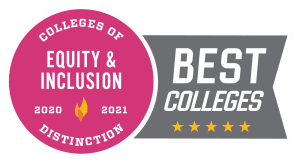Promoting Your Commitment to Equity and Inclusion
While academics, educational opportunities, faculty quality, and student outcomes are all features that prospective students care about, it’s becoming more and more important to ensure that your institution is also able to provide a college experience that is welcoming, equitable, and inclusive for students of various backgrounds, identities, and circumstances.
According to the American Council on Education, students of color jumped from 29.6 percent of the undergraduate population to 45.2 percent in just twenty years (from 1996 to 2016). While such a surge is indicative of both the overall diversification of the country as well as significant shifts in opportunity and access for underrepresented communities, the world of academia continues to be predominantly white, and higher education continues to be a large financial hurdle. It’s with the massive spike of enrollment against these disparities, therefore, that the schools best equipped to foster an equitable, inclusive, and welcoming campus community and educational experience are going to be in the best position to recruit students successfully well into the future.
Below are just a few effective marketing strategies to reveal to prospective students your school’s commitment to diversity and inclusion. With a clear demonstration of your strengths, students of color and other underrepresented identities are more likely to consider your institution as their home for the next four years.
Demonstrate a Commitment to Financial Support
Especially for first-generation college students, the extent to which your institution helps finance its education is a crucial indication of how feasible it is to attend. Of course, it’s necessary to foster a fundamentally hospitable campus environment, but a welcoming campus community can’t be truly welcoming if economically disadvantaged students aren’t actually able to enroll.
That’s why it is important to communicate how your school provides financial support for first-generation students as well as students from marginalized backgrounds. Regardless of where a student falls on the socioeconomic ladder, they will be reassured that your school acknowledges and cares about their unique experiences and is committed to allocating resources to help them enroll and continue to be successful all the way through graduation.

One way to do this is to feature relevant scholarships, grants, and work-study aid in your marketing, highlighting testimonials from a diverse selection of students who have received financial support and offering easy ways to learn more through a one-on-one conversation with someone of a similar background or experience (be that a current student, alum, or staff/faculty member).
The University of Washington in St. Louis’ website has a clear, dedicated page about affordability for low-income first-year students. Additionally, the school created its Deneb STARS program, which provides four years of support to a select group of students who are the first in their family to attend college. Resources like these are worth promotion throughout a school’s marketing. When you make a point to shout out your own school’s sources of aid for minority populations, you will better assure that your school is striving to be inclusive and welcoming to students of various backgrounds.
Highlight Relevant Offices, Clubs, and Initiatives Aimed at Promoting Equity and Inclusion
It’s important to help students know that they will be able to meet and form relationships with others who share similar backgrounds and identities once they get to campus. College is already going to be an intimidating environment full of unfamiliar experiences, so it’s critical to draw attention to the different multicultural clubs, offices, and initiatives on your campus to help ease prospective students’ concerns no matter their background or circumstances. And this means not merely mentioning certain offices or clubs, but rather providing compelling and descriptive details along with relevant photographs and/or videos.
Of course, posting stock photos of a diverse group of students isn’t enough; if anything, it can even be misleading. You should instead provide actual photos of your students involved in certain clubs or interacting with staff and faculty at spaces dedicated to equity on campus. Highlight testimonials of students—in both written and/or video form—that feature how they found support and fellowship on your campus.
You can also point to certain statistics or reports that reveal how your institution is faring when it comes to securing an equitable and inclusive campus. Even if your campus does not have an explicitly diverse population, it is all the more effective to emphasize how it is inclusive. Student satisfaction surveys, or even an exhaustive network of support and resources, are great ways to show that equity is a priority no matter the size of your minority student population. Again, it is always better to show rather than tell when it comes to marketing to this audience (or, really, any audience).
Santa Clara University’s website features a tremendous amount of information for relevant students, including details about its inclusive hiring processes, information on undergraduate population breakdowns and trends, and how the school offers various education and training programs throughout the year for its community members.
As is the case of student testimonials, statistics, and trend reports, third-party validation is key to making sure students know that your school isn’t simply telling them what they want to hear. Third-party validation can come in the form of an award or recognition for your school’s commitment to diversity and inclusion. In fact, this is something that Colleges of Distinction weighs heavily when evaluating schools for its cohort. The schools that are indeed committed to creating an inclusive environment are awarded an Equity & Inclusion badge that they can highlight in their marketing.

The University of North Texas in Denton is an example of one school that understands the importance of highlighting third-party endorsements. In a recent press release, the school makes it known that it received a Higher Education Excellence in Diversity (HEED) award.
The Entire Campus Community Should Reflect Your School’s Commitment to Equity and Inclusion
While there is an obvious benefit to attending a school with peers who share similar identities and values, it is just as important for students to see themselves represented in your faculty and staff. In fact, a number of studies have found that students of color, women, and queer students all find higher rates of completion and success when they are taught by professors from similarly marginalized populations. It can be really helpful for a student to feel that they have recourse to a minority-identified faculty or staff member for empathetic, experienced mentorship and support.
Again, this is where it’s important to have an area on your site that details how your institution commits to inclusion from all angles, including the personal relationships with staff and faculty members. What kind of mentorships are you offering for these students? Are there faculty members and staff available to walk with these students or answer their questions as they go through the application process? Are there testimonials from certain members of your staff and faculty detailing how they have found your school to be both equitable and inclusive? These things and others like them need to make their way into your marketing.
Further, a commitment to a diverse faculty and staff reveals that your campus is serious about inclusion—that it’s not just trying to achieve “diversity” as an impersonal outcome to increase enrollment revenue, but rather that it understands how a multiplicity of voices and backgrounds makes for a better educational and communal experience for everyone.
As we have written about before, the University of Wisconsin-Madison offers a good example of a school committed to making sure its staff and faculty—not just its students—are part of a diverse and inclusive community. As Jeffrey S. Russell, the Dean of Continuing Studies and Vice Provost for Lifelong Learning at the University of Wisconsin-Madison, writes,
“It all starts with a more effective search and screening process. We’re doing a better job of assembling diverse hiring committees … At the outset of each search, we encourage committee members to recognize their assumptions and biases to ensure a truly fair assessment of each candidate.”
By being able to point to a campus community that is not only diverse, but also welcoming at all levels in your marketing, you stand a much better chance of convincing prospective students of all backgrounds that your school offers an experience they will find both equitable and inclusive.



